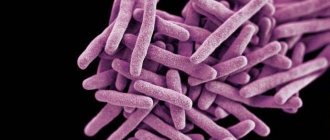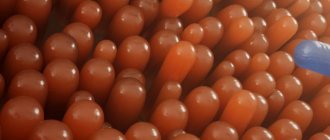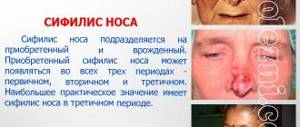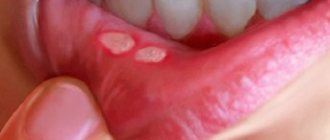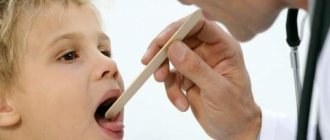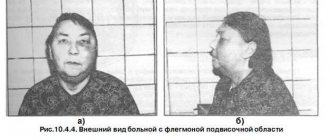What is atopic dermatitis?
"Dermatitis" means inflammation of the skin.
And the term “atopic” refers to a hereditary predisposition to allergies. Most often, this disease first appears in childhood. In most patients, by the age of five, atopic dermatitis goes into stable remission, but often the disease can continue in adults. The exact causes of the disease have not been established, but modern medicine believes that atopic dermatitis is a multifactorial disease, which is based on a genetic predisposition to atopic diseases.
A tendency to atopic dermatitis can occur when there are provoking factors in your life:
- psycho-emotional stress;
- disturbance in the functioning of internal organs;
- unfavorable environment.
It has been noticed that atopic dermatitis often worsens during the cold season, so if skin problems arise with the onset of cold weather, there is reason to think about visiting a dermatologist.
The main symptom of atopic dermatitis is itching of varying degrees of intensity. Sometimes it is so strong that it can disturb the patient’s sleep. Inflammation and dryness of the skin, various rashes that often accompany the disease, cause very unpleasant sensations.
Etiology and pathogenesis of atopic cheilitis
In the development of the disease, an undoubted role belongs to genetic factors that create a predisposition to the so-called atopic allergy. Allergens can be food products, medications, pollen, household dust, microorganisms, cosmetics, etc. Rarer allergens are physical and bacterial factors, as well as autoallergens.
The clinical implementation of atopic allergy in this disease is facilitated by disruption of the central and autonomic nervous system.
There are several stages of the disease:
- Infant (age up to two years).
During this period, rashes, as a rule, are swollen redness, peeling on the skin of the face, on the extensor surfaces of the arms and legs. In more severe cases, blisters, weeping, and crusts may appear. At this stage, as a rule, there is a clear connection with food irritants.
- Children's (from two to 12 years old).
From the age of two years, atopic dermatitis manifests itself in the form of rashes on the skin of the elbows, popliteal fossae, and the back of the neck. The tendency to weeping decreases, nodular inflammatory elements are more often present, increased skin dryness, peeling and irritation remain.
- Adult (over 12 years old).
In most patients, by this age the disease goes into stable remission (no manifestations of the disease). As the disease continues into adulthood, intense skin itching comes first. Severe skin dryness and flaking persist. Skin rashes can be varied (bubbles, nodules, areas of redness). In most patients, there is a clear connection between exacerbations and psycho-emotional factors.
The above symptoms refer to periods of exacerbation of atopic dermatitis. During the “lull” the disease can only manifest itself as increased dryness of the skin.
Recommendations for people suffering from atopic dermatitis
- Those who suffer from atopic dermatitis have skin that is very sensitive to external influences. Frequent water procedures are not advisable for such people, and they need to wash themselves using special softening and moisturizing agents, and not use a washcloth. After washing, it is better to remove water from the surface of the skin using blotting movements rather than the usual wiping.
- An emollient and moisturizing cream for atopic dermatitis must be used daily. In clothing, you should give preference to cotton and avoid skin contact with wool, synthetic and coarse fabrics.
- For those who suffer from atopic dermatitis, it is better not to have carpets in the house, as well as objects and furniture that contribute to the accumulation of dust. It is better to store books and clothes in locked cabinets and vacuum them regularly. It is better to use pillows and blankets made from synthetic materials rather than down ones.
- This disease imposes some dietary restrictions. Especially in infancy. It is very important that parents keep a food diary for their baby. It will help to clearly trace the connection between the use of a particular product and the exacerbation of atopic dermatitis.
- Many children have hypersensitivity to milk and egg whites, which disappears with age. In the future, the significance of food allergies decreases. In adults, true food allergies are extremely rare.
However, adults with atopic dermatitis should also avoid foods that are rich in histamine or that increase its release in the body:
- fermented cheeses
- sauerkraut
- smoked sausages
- tomatoes
- cheeses
- marinades
- Brewer's yeast
- alcohol, etc.
In addition, if the patient notices a deterioration in the condition of the skin after consuming a particular product, then this product should also be excluded from the diet. During an exacerbation of the disease, a more strict diet is required, excluding all irritating foods: hot, smoked, spicy, marinades, fatty, sweet, baked goods, fried, citrus fruits, honey, nuts, chocolate, alcohol. The sun is a strong factor affecting skin condition.
About the clinic
Euromed Clinic is a multidisciplinary family clinic in the center of St. Petersburg.
- Calling a doctor to your home
- 24/7 therapist appointment
- Tests, ultrasound, x-ray
- Whole body diagnostics
- Hospital and surgery
- Vaccination
Find out more about the clinic
Allergic and atopic reactions of the skin and oral mucosa
Allergic contact dermatitis occurs in patients with hypersensitivity to a specific substance that acts as an allergenic trigger. Allergens can be: chemical salts of chromium, nickel, cobalt, turpentine and its derivatives, formaldehyde resins, cosmetics, insecticides, synthetic detergents, medications (antibiotics, sulfonamides, novocaine, formalin). Contact dermatitis (cheilitis) can be caused by cosmetics. Allergic contact stomatitis develops in prosthetic wearers with intolerance to materials, such as plastic.
In allergic contact dermatitis, cheilitis, stomatitis, erythema, papular and/or vesicular, bullous and urticarial elements are determined against the background of pronounced swelling of the connective tissue. Subjective sensations are noted - itching, burning, a feeling of heat in areas of contact with one or another irritating substance. However, in some patients, clinical manifestations may extend beyond the zones of exposure to allergenic agents.
Toxic-allergic dermatitis (toxidermia)
It most often develops under the influence of drugs and foods. Clinically common drug and food toxicoderma is manifested by a variety of rashes: true polymorphism of rashes. The appearance of numerous spotted, urticarial, papular, papulovesicular and, less commonly, pustular elements of the lesion, accompanied by itching, is possible. Sometimes total erythroderma develops.
Often the mucous membranes are involved in the process, on which edema, erythematous, hemorrhagic, and vesicular-erosive elements occur. The rashes are localized in areas susceptible to injury or throughout the entire oral mucosa.
The acute phase of the disease is characterized by intense itching, papules and vesicles located on an erythematous base. They are often accompanied by severe excoriations and erosions. Fixed toxicdermia may develop, the cause of which is most often the use of medications, for example, sulfanilamide erythema. One or more swollen hyperemic spots, round or oval in shape, appear, in the center of which a bubble may form. After the drug stops working, the inflammatory phenomena subside, and the stain persists for a long time. In case of repeated application of the same allergen, the spot again becomes hyperemic and undergoes a similar evolution. Fixed toxicoderma is localized on smooth skin and mucous membranes.
The acute phase of the disease is characterized by intense itching, papules and vesicles located on an erythematous base. They are often accompanied by pronounced excoriations and erosions, and the release of serous exudate. The subacute phase is accompanied by erythema, excoriation and peeling against the background of lichenification of the skin. In the chronic course, thickened plaques on the skin, an accentuated skin pattern (lichenification) and fibrous papules are observed.
Atopic dermatitis
The concept is collective in nature and includes terms denoting allergic inflammation of the skin (“Beignet’s pruritus”, “atopic neurodermatitis”, “childhood eczema”, etc.), with the exception of urticaria and contact dermatitis.
The term “trigger” is used to refer to the causes that cause the appearance and exacerbation of atopic dermatitis. Factors identified from the anamnesis can be both truly allergenic (protein substances) and non-allergenic irritants (non-protein chemicals: food additives, clothing dyes, overheating, dry air, scratching the skin, stress). They cause the classic pattern of “atopic” reaction of the immune system (allergen-antibody interaction, usually with the participation of class E immunoglobulins). Non-allergenic factors either intensify an existing allergic reaction or cause inflammation and symptoms of dermatitis on their own.
In patients with long-term chronic atopic inflammation, changes can exist simultaneously in different areas of the skin and mucous membranes.
Mild atopic dermatitis: mild itching, slight hyperemia, slight exudation, slight peeling, single papules, vesicles, slight enlargement of lymph nodes (up to the size of a pea). Moderate: Moderate to severe itching that disturbs sleep. Multiple lesions of the skin and mucous membrane with severe exudation or lichenification, multiple scratches and hemorrhagic crusts. The lymph nodes are noticeably enlarged (to the size of a bean).
Severe course: the itching is severe, painful, often paroxysmal, seriously disturbing sleep and well-being. Multiple, confluent lesions, severe exudation or lichenification, deep fissures, erosions, multiple hemorrhagic crusts. Almost all groups of lymph nodes are enlarged to the size of a hazelnut (in very severe cases - to the size of a walnut).
Diagnostic criteria for atopic dermatitis (stomatitis) combine the subjective sensation of itching and objective signs: dermatitis; presence of allergic status in close relatives; widespread dry skin; development of dermatitis before 2 years of age.
Laboratory tests include immunological, serological, allergological tests. An increased level of concentration of total serum immunoglobulin E and eosinophilia in peripheral blood may indicate atopic genesis of stomatitis. Skin tests (prick, scarification and patch tests) play an important diagnostic role in identifying allergens that cause exacerbation.
Intradermal tests are performed with inhalant allergens in difficult diagnostic situations. Intradermal tests with food products are strictly prohibited due to excessive sensitivity and the possibility of provoking an anaphylactic reaction.
Diagnostic criteria for atopic dermatitis combine the subjective sensation of itching and objective signs: dermatitis; presence of allergic status in relatives; widespread dry skin The application test is simple and accessible: the test substance is applied to the skin of the inner (flexor) surface of the forearm. The results of application tests are assessed during the first hour (immediate reaction) and after 24-48 hours (delayed reaction) based on skin hyperemia, itching, swelling, weeping at the site of application of the substance. Contraindications to skin testing are exacerbation of atopic dermatitis, acute intercurrent infections, chronic diseases in the stage of decompensation, pregnancy, tuberculosis, mental illness, collagenosis, malignant neoplasms.
Special allergy tests are based on genetic predisposition to atopy, which is determined by a significant number of factors: interleukins, especially IL-4 and IL-13, other cytokines, dendritic cells, Langerhans cells. In this regard, in a blood test during atopic reactions, an increase in the number of activated T-lymphocytes and Langerhans cells, and increased production of IgE by B-cells are noted.
In patients with atopic dermatitis, radioallergosorbent test (RAST), enzyme-linked immunosorbent assay (ELISA), multiple allergosorbent test (MAST) and other in vitro methods are used to detect specific serum IgE. Patients with suspected infection of the skin and mucous membrane are examined to identify viruses or bacteria that cause complications. The most common fungal flora, herpes virus, dermatophytes, streptococci, staphylococci.
Three fundamental positions in the treatment of atopic dermatitis:
- Therapeutic and cosmetic skin care.
- External anti-inflammatory therapy.
- Elimination of causative factors causing exacerbation (allergenic and non-allergenic triggers).
General rules for caring for the skin of patients with atopic dermatitis: eliminating dry skin and restoring the damaged lipid layer of the skin; exclusion (limitation, as far as possible) of exposure to irritating factors on the skin.
To eliminate dry skin, various moisturizers and emollients are used. For the purpose of softening, cosmetics based on physiological lipid mixtures should be used. Ceramides, free fatty acids and cholesterol are in a ratio (from 1:1:1 to 3:1:1, respectively). At the same time, many cosmetic products contain water, i.e., both moisturizing the skin and restoring its lipid composition are achieved (Mustela cream). A moisturizer and emollient must be applied to the skin as often as required so that the skin does not remain dry “for even a single minute.” As a rule, in the first days, 5-10 times the application of products to the skin is required, and subsequently the frequency of treatment is reduced to 3 times a day.
Antibacterial and antifungal drugs are used both independently and in double combination (glucocorticosteroid and antibiotic or antifungal agent), as well as in triple combination (glucocorticosteroid, antibiotic and antifungal agent): pimafucort, triderm, acriderm GK.
The following drugs have an anti-inflammatory effect: ASD III fraction, sulfur, tar, naftalan oil, zinc oxide, salicylic acid, dermatol, ichthyol. For the treatment of dermatitis in the acute stage, liquid forms of external antiseptics and combined action preparations (Castellani liquid, fucorcin, preparations containing salicylic acid, and others) are used as disinfectants and disinfectants, especially in cases of secondary infection and weeping of lesions.
The following drugs have an anti-inflammatory effect: ASD III fraction, sulfur, tar, naftalan oil, zinc oxide, salicylic acid, dermatol, ichthyol Anti-inflammatory activity is exerted by external glucocorticosteroids of “increased safety”: advantan (methylprednisolone aceponate), afloderm (alclomethasone dipropionate), lokoid ( hydrocortisone 17-butyrate), elocom (mometasone furoate). Advantan is applied to any area of the skin, including folds and face (once a day). Afloderm is used 1 to 3 times a day. Lokoid is used to treat dermatitis of any localization (1-3 times a day). Elokom can be applied to the skin of the face once a day.
Treatment with external glucocorticosteroids is the most effective method of treating children with atopic dermatitis. Therapy with external corticosteroids should be carried out long-term, until complete remission of the disease occurs.
Atopic cheilitis
It can occur independently or accompany the general picture of atopic dermatitis - a chronic lichenifying inflammation of the skin that occurs as a result of an allergic reaction that is triggered by both atopic and non-atopic mechanisms. The disease begins acutely, causing itching and clearly demarcated pink erythema, and sometimes there is swelling of the red border of the lips. Crusts appear at the scratch site. Acute phenomena subside, lichenification develops: the red border is infiltrated, covered with small scales and thin grooves. Small cracks form in the corners of the mouth. The process does not spread to the mucous membrane and Klein's area, but it involves the skin around the lips.
Atopic cheilitis occurs over a long period of time, exacerbations occur mainly in the autumn-winter period, and remission occurs in the summer. Atopic cheilitis in children manifests itself quite clearly: swelling of the skin in the perioral area, infiltration and peeling of the red border of the lips, radial striations. Papular rashes in the corners of the mouth are characteristic. Manifestations of atopic cheilitis and its relapses have cosmetic consequences (changes in color, lip architecture), disrupt the child’s nutrition, and interfere with the sanitation of the oral cavity. By the end of puberty, most people experience self-healing, but minor rashes may persist, mainly in the corners of the mouth. In some cases, psychosomatic disorders may occur.
Depressive reactions in patients with somatic and neurological diseases, which are based on factors including objective signs of bodily suffering, are also characteristic of dental patients.
In some cases, patients believe that character changes due to an aesthetic defect affect communication with loved ones or career growth. A special group in this regard is represented by actors, singers, teachers, and doctors. Excessive fixation of attention on individual anatomical features contributes to the emergence of psychogenic disorders, which may be the result of the idea of “losing one’s physical attractiveness” and inferiority in the eyes of loved ones. They can form as a result of diseases or conditions accompanied by changes in appearance. For example, the removal of front teeth leads to malocclusion (reduction of the lower third of the face), speech, and deterioration in the aesthetics of the dentition. The patient tries to talk less, stops smiling, and develops withdrawal. Soft tissue defects in the perioral area can lead to similar manifestations.
In some cases, patients believe that character changes due to an aesthetic defect affect communication with loved ones or career growth. A special group is represented by patients whose dental diseases can directly affect their professional activities: actors, singers, teachers, doctors. Their reactions are often of a violently emotional or hysterical nature; as a rule, there is a discrepancy between the severity of the condition and the psycho-emotional behavior of the patient. A person’s self-esteem of his own morphological characteristics depends on gender, age, and constitution. Young people, as well as unbalanced individuals, react more sharply to aesthetic flaws.
Nosogenic depression should be differentiated from psychogenic depression, when primary mental state disorders lead to refusal to communicate with the dentist. Complex treatment of nosogenic depression is carried out by a psychologist or neuropsychiatrist: medication, reflexology, physiotherapy (electrosleep). The dentist is required to comply with medical ethics and deontology, attentive attitude towards the patient, the ability to convince him of the effectiveness of modern methods of treatment in dentistry, and high-quality sanitation of the oral cavity.
Diagnostic criteria for atopic dermatitis include the mandatory presence of itchy skin (red border of the lips) and three or more of the following signs: the presence of dermatitis in the area of the flexor surfaces of the extremities; bronchial asthma or hay fever in close relatives; widespread dry skin; the first manifestations of dermatitis before 2 years of age. To clarify the diagnosis, consultation with an immunologist, allergist, or dermatologist is required.
Skin tests can be performed on almost all allergens. To exclude possible anaphylactic reactions, testing with allergens to which hypersensitivity is obvious should not be used.
Atopic cheilitis occurs over a long period of time, exacerbations occur mainly in the autumn-winter period, and remission occurs in the summer. In some cases, psychosomatic disorders may occur. To assess the allergic reaction in vivo, a mucosal test is performed on an intact area of the mucous membrane of the upper lip or hard palate. Removable dentures are made of plastic, on the inner surface of which there are 2 recesses. One is filled with an aqueous solution of the suspected allergen, the second with a physiological solution, the prosthesis is fixed on the teeth to create contact between the mucous membrane and the test substance. After 15-25 minutes, the prosthesis is carefully removed and the intensity of the reaction is determined after 1, 24 and 48 hours.
General treatment of atopic cheilitis requires the appointment of hyposensitizing therapy, including the use of antihistamines (suprastin 0.025 - 2-3 times a day; fenkarol 0.025-0.05 - 3-4 times a day; tavegil 0.001 - 2 times a day; loratadine ( Claritin) 0.01, Zyrtec (Cetrin) 0.01, Zaditen 0.01 - 1 time per day). In a number of patients, histaglobulin has a good therapeutic effect, which is prescribed in courses of 6-8 injections intradermally 2 times a week in increasing doses, starting from 0.2 ml to 1 ml, sodium thiosulfate orally or intravenously, sedatives (trioxazine, seduxen, melleril and etc.). In case of persistent atopic cheilitis, corticosteroids can be prescribed orally for 2-3 weeks: prednisolone (children 8-14 years old, 10-15 mg/day, adults, 15-20 mg/day) or dexamethasone, which is more effective. Corticosteroid ointments are prescribed locally (1% hydrocortisone acetate cream (hydrocortisone), 0.1% hydrocortisone butyrate ointment and cream (Laticort), 0.1% mometasone ointment and cream (Elocom), 0.5% - prednisolone ointment, 0.1% triamcinolone acetonide ointment (fluorocort), 0.025% fluorcinolone acetonide ointment and gel (flucinar).Bucchi rays have a positive effect.
Spicy, salty, spicy foods, alcohol should be excluded from the diet, and the amount of carbohydrates should be sharply limited.
Conclusion
The manifestation of allergic, toxic-allergic, and atopic reactions on the skin is often accompanied by pathological changes in the oral mucosa and the red border of the lips. Diagnosis of diseases requires not just a thorough examination, but specific laboratory tests to identify the etiological factor. Local and general treatment, including impact on individual links of etiopathogenesis, ensures the achievement of a positive result.
How to treat atopic dermatitis?
- The first step in treating atopic dermatitis is identifying and eliminating triggers. At the same time, antihistamines are prescribed to eliminate the itching that bothers the patient. When choosing a drug, it is strongly recommended to consult a doctor so that he can help not only choose a medicine, but also calculate the dose appropriate to the patient’s age and the nature of the disease.
- In addition, local anti-inflammatory drugs (creams, ointments), including hormonal ones, are used in the treatment of atopic dermatitis. The choice of drug should be approached very carefully, especially for infants. Consultation with a doctor is required. Self-medication may lead to undesirable results. The same recommendation applies to drugs for the treatment of dysbiosis, which is important in the treatment of atopic dermatitis.
- If infectious complications occur (often associated with scratching), then antifungal, antiviral and antibacterial drugs are used for treatment.
Treatment of atopic cheilitis
General treatment of atopic cheilitis : use nonspecific desensitizing therapy, including antihistamines. In a number of patients, histaglobulin has a good therapeutic effect, which is prescribed in courses of 6-8 injections subcutaneously 2 times a week in increasing doses, starting from 0.2 to 1 ml, sodium thiosulfate 30% solution, 10 ml intravenously, sedatives and tranquilizers according to indications.
Use vitamins B1, B6, B12, C, PP, multivitamins with microelements. In case of persistent atopic cheilitis, oral corticosteroids can be prescribed for 2-3 weeks: prednisolone (children 8-14 years old, 10-15 mg/day) or dexamethasone, 1-3 mg/day. Vascular drugs (tanakan, cavinton, stugeron).
Local treatment of atopic cheilitis : corticosteroid ointments are successfully used, 4-5 times a day for 20 minutes. Bucca's rays have a good effect. Spicy, salty, spicy foods, alcohol should be excluded from the diet, and the amount of carbohydrates should be sharply limited. Applications of keratoplasty products, vitamins A, E in oil, Shostakovsky balm, Tezana emulsion, KF paste, Unna ointment, solcoseryl dental adhesive paste are shown. Radiation of a helium-neon laser, daily, No. 5-10.
Did you like the article? Share with friends
0
Similar articles
Next articles
- Eczematous cheilitis
- Plasma cell cheilitis
- Chronic cracked lip
- Glossitis
- Desquamative glossitis
Previous articles
- Actinic cheilitis
- Meteorological cheilitis
- Contact allergic cheilitis
- Glandular cheilitis
- Exfoliative cheilitis

